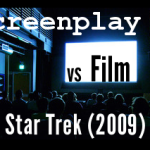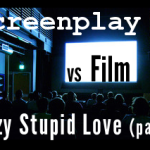You probably like to read the “sexy” how-to screenwriting articles. You know the ones.
They tell you how you to write dialogue as distinctive as Quentin Tarantino’s.
Or how to write a script Leonardo DiCaprio would want to star in. Or how to sell your script even though you don’t have any connections in Hollywood.
Don’t get me wrong. These articles are helpful. I’ve written a couple myself. But they usually avoid mentioning a key ingredient that’s at the heart of all great screenplays.
So what is this not-so-sexy script essential that screenwriters don’t want to hear about?
Clarity.
Clarity isn’t fun to talk about. (Certainly not as much fun as rubbing elbows with Leo.) But it’s something which most amateur screenplays need more of. Not more explosions, not more witty banter, but more clarity.
If your script isn’t as clear as Baccarat, then studio readers are going to get confused when they read it. If they’re confused by the wording of a joke, they won’t be able to appreciate your Diablo Cody rapier wit.
If they’re confused about why your hero visited a tattoo parlor at three in the morning, they won’t be able to appreciate his awesome combat skills with a two coil tattoo machine.
Your screenplay may have all the gags of a raunchy comedy or all the thrills of a Daniel Craig Bond movie, but if you haven’t clearly communicated these scenes to your readers, they won’t be entertained.
They’ll just be plain ole confused. Even a mere blip of confusion can make them put down your script in favor of someone else’s.
To prevent this from happening to your script, avoid these 3 common ways screenwriters confuse studio readers. Ignore this list at your peril!
Clarity Wrecker #1: You have too many characters
When you meet a bunch of new people at a party, unless you’ve studied Jedi mind tricks, you probably only remember a few of their names.
The same principle applies to screenwriting: readers can only remember a certain number of characters in your screenplay. After that, everyone blurs together.
It’s much easier for you to keep track of a large cast of characters because it’s YOUR story. But for a reader who’s approaching your script with a fresh pair of eyes, it’s much more difficult.
If your cast of characters is too large, he’s liable to get confused about who’s actually doing what.
So make it easy for him.
In Your Screenplay Sucks (horrible title, but wonderful book), Bill Akers claims that 8 is the magic number of characters to name. That sounds like a good number to me.

Achieve clarity in your screenplay with the magic number 8!
Although, as with everything, there are exceptions. If you’re writing a movie like OCEAN’S 11, you need to give names to all eleven of your con men crew. If you’re writing a sprawling, 120 page epic (like a war movie or medieval saga), you also have more leeway. Just don’t go overboard.
Once your script includes more than 8 or so named characters, you should do a little reassessing, perhaps combining two characters into one or eliminating a scene or subplot altogether.
This won’t just reduce the burden placed on a studio reader’s taxed memory. It will also make your screenplay stronger. With fewer characters in your script, the audience’s emotional investment in each is less likely to get diluted.
Additionally, when you combine characters, they typically become nuanced, three-dimensional personalities who are more than just exposition devices.
That’s not to say you can only have 8 characters in your script. But you should minimize the number of characters you name.
Once you’ve hit the 8-character limit, try to name characters according to their relationship to your hero or their role in society. So this hypothetical roster of characters…
- Linda Maplewood
- Peter Dulgarian
- Larry Schiller
- Moira Dickens
- Donald Frieburg
- Nathaniel Plymouth
…would turn into this:
- Albert’s mother
- Albert’s college roommate
- Albert’s dentist
- Jittery salesgirl
- Gold-toothed divorce attorney
- Platoon captain
Nameless characters can still exude personality. The excerpt below from THE BOURNE IDENTITY, written by Tony Gilroy, should provide you with plenty of inspiration:
TWO SAILORS ON DECK. One African. One Sicilian. Rugged, beaten lifers dressed in filthy work clothes. They’re up near the bow, tucked in behind a container. They’re smoking hash — trying to — fighting the wind —
AFRICA gets his hit. SICILY pulls the pipe away.
AFRICA moves to the rail. Holding the smoke. Exhaling into the wind. Standing there — staring out over the water — until, suddenly —
AFRICA
—dites donc! — dites donc! —
(calling back to his partner–)
— amigo! — vite! — vite! —
BECAUSE WAY OUT THERE
THERE’S SOMETHING FLOATING.
In addition to limiting the number of characters you name, give this special group of named characters memorable character introductions. Something more than their age or ethnicity or hair color.
Think of these descriptions as study aids which will help “lock” this character’s identity in the reader’s mind.
Another good tip is to introduce your characters one at a time, ideally one per scene. As Alex Epstein observes in Crafty Screenwriting:
Suppose your story begins with your cop hero and his partner getting assigned to a routine surveillance job that will turn into something bigger.
Rather than start with the assignment itself–hero, sidekick, and their boss all at once–you may want to find a way to show the hero alone, then linking up with his partner before they both go into their boss’s office.
Clarity Wrecker #2: You unnecessarily obscure your character’s identity
Have you ever written a scene where you’ve kept a character’s identity shrouded in secrecy? You know what I mean. Hidden behind a taxi, A CROUCHED FIGURE observes the heroine exiting her apartment. A MAN pushes his way through a throng of New Year’s Eve revelers. We don’t see his face, just his back.
Then, later in your script, you’ll do a big reveal. The HUNCHED FIGURE was the heroine’s own stepfather! The MAN was really the villain’s apprentice!
Sure, keeping a character’s identity secret until an opportune moment can yield major dividends. Done well, it can surprise even the most jaded of studio readers.
At the same time, this technique can go terribly wrong, especially if your big reveal isn’t very smooth. (Or in a worst-case scenario, you forget to connect the dots and neglect the big reveal altogether).
This certainly won’t impress a studio reader. He’ll just be incredibly confused–which I think we’ve established by now is a very bad thing. Even if you reveal your character’s identity with skill, you should double check to make sure all of this setup was worth the payoff.
Take the original spec screenplay for SNOW WHITE AND THE HUNTSMAN. In it, screenwriter Evan Daugherty described how the evil queen Ravenna first achieved her powers:
RAVENNA’S MOTHER
Drink.
Ravenna’s Mother forces her daughter to guzzle down the foul tasting potion.
And then, Ravenna’s Mother grabs a curved dagger and gently CUTS A SCRATCH into her daughter’s arm.
Ravenna recoils at first, but it soon becomes clear that she feels no pain. Seconds later, the blood is drawn back into her body. And Ravenna’s wound miraculously closes up.
THAT’S WHEN WE’LL REVEAL that SOMEONE is watching this scene play out. An EYE peeks through a hole in the wooden siding of the wagon…but we won’t know exactly who is watching.
RAVENNA’S MOTHER
(to Ravenna)
Now, your beauty–and your life–can never be taken from you.
(a long moment)
Except by one…
That’s intriguing. But we won’t hear anything else for now.
Who’s that figure lurking in the shadows? You have to read on till page 52, twenty-three pages later, to find out:
INT. RAVENNA’S WAGON – DAY – [FLASHBACK]
They are the same COLORLESS EYES that were peeking into the wagon during Ravenna’s flashback. A YOUNGER FINN [17], peeks into the wagon, witnessing Ravenna’s magical transformation at the hands of her mother.
We pick up the conversation where we left off:
RAVENNA’S MOTHER
Now, your beauty–and your life–can never be taken from you.
(a long moment)
Except by one.
Ravenna’s Mother leans in close, whispering to her daughter.
RAVENNA’S MOTHER (CONT’D)
By fairest blood, it is done…And only by fairest blood can it be undone.
To be fair to Daugherty, his big reveal isn’t confusing.
But, I don’t think masking Finn’s identity in the first scene was worth all the effort.
The revelation of his identity occurs at a point in the script when the audience would have been much more interested in the story unfolding in the present than in a flashback to Finn and Ravenna’s past.
You’ll notice that in the movie version of SNOW WHITE, when Ravenna flashbacks to her childhood, we know Finn witnessed everything. It’s not kept a secret from us.
If you’re interested, here are more tips from SNOW WHITE AND THE HUNTSMAN »
For comparison’s sake, let’s take another look at the THE BOURNE IDENTITY.
For the first 21 pages of Gilroy’s draft, he refers to Jason Bourne as THE BODY, then simply as THE MAN:
THE BODY. Laid out on a coat. Comatose. Cold. Stiff. Motionless beneath a thin, stained blanket. But the eyes — there’s something flickering beneath the lids…
We will now call him THE MAN.
Only after Bourne recovers a part of his identity does Gilroy start referring to him as Bourne:
DEEPER INSIDE THE BANK. Elevator doors open. THE MAN steps out. MR APFEL waiting there. He’s an anal Zurich banker.
APFEL
Mr Bourne. Good morning. I assume you’re here about your box.
(beat)
Mr Bourne?
THE MAN hesitates. Is that his name? Bourne?
THE MAN
Yes. The box.
CUT TO
SAFE DEPOSIT VIEWING ROOM. A large white room. White desk. Great light. Total privacy. A birthing room.
THE MAN sitting there. A DEPOSIT GUARD placing a large SAFETY-DEPOSIT BOX before him and then leaving the room. Closing the door behind him.
THE MAN is alone. And here it is, right in front of him. Here are the answers. He lifts the lid.
ANGLE ON
THE BOX. There’s a shallow tray on top. And in this tray: A beat-up passport in the name of Jason Bourne. An Italian driver’s license with a Genoa address. Credit cards for Jason Bourne.
ANGLE ON
THE MAN. Holding these objects, as if by holding them he might absorb their essence. Forcing himself to believe. This is him. His picture. There it is. He’s Jason Bourne.
BOURNE
My name is Jason Bourne.
(his voice echoing in this room–)
Hi. I’m Jason. Jason Bourne. Jason Bourne, nice to meet you.
In this case, shrouding Bourne’s identity in secrecy paid off in spades.
It gave the protagonist an aura of mystery, captivating readers’ interest right away. At the same time, because Bourne himself doesn’t know who he is, masking his identity meshes with the story as a whole.
The next time you’re tempted to hide your character’s identity within a scene–or for several pages in your script–make sure that covering your character with a cloak of invisibility is well and truly justified.
Assess the value of the payoff scene. Will the audience delight in the reveal (like in THE BOURNE IDENTITY)?
Or will they be irritated and/or confused that you kept them in the dark (like in SNOW WHITE)?
Clarity Wrecker #3: You assume we understand your character’s motivation
The first time I watched SHERLOCK HOLMES 2: GAME OF SHADOWS, I was less than impressed. I thought the banter between Holmes and Watson (which I had adored in the first movie) was self-indulgent.
I was puzzled by the presence of the doctor who, despite Holmes’s attempts to save him, was killed by a poisonous dart. I was horrified–not amused–by Watson’s ramshackle appearance at his wedding.
But I soldiered on.
And I’m glad I did because once the story reached the Meinhard factory, it captured my attention and didn’t let go. Recently, I watched it again, and had a completely different reaction.
Holmes and Watson’s banter was not excessive; I was amused by Watson’s unkempt arrival to his own wedding. I nodded knowingly at the doctor’s unfortunate demise.
When I compared my second viewing with the first, I realized what had made all the difference. The first time I watched SHERLOCK HOLMES 2, I was confused by Holmes’s fascination with the doctor and with Madame Simza, “Sim” for short.
What did they have to do with unraveling Moriarty’s schemes?
Unfortunately, that confusion colored my entire experience.
Because I was too preoccupied trying to process their roles in the story, I couldn’t fully enjoy the parts I could understand (like a really cool fight sequence with a Cossack spy).
The second time I watched the sequel, I knew who the doctor and Sim were, and more importantly, why they were relevant. Because I wasn’t confused, because I understood Holmes’s motivation, the second viewing was infinitely more enjoyable.
Admittedly, I was tired when I watched the movie the first time. I wasn’t concentrating that hard. But in all likelihood, neither will the studio reader who’s been assigned to do coverage to your story.
So don’t keep your hero’s motivations close to his vest. In most cases, the wisest strategy is to spell them out.
A lot of times screenwriters obscure character motivations because they’re too close to the story. They know why their hero is chasing down a gypsy fortune-teller at a stag party and they assume that audiences share that same knowledge.
But we don’t.
Going back to SNOW WHITE AND THE HUNSTMAN,in the DVD extended edition of the film, Ravenna orders her brother Finn to lock up Snow White, muttering, “you never know when royal blood may be of value.”
This line was not in the theatrical edition of the movie, which was a really poor editing decision.
If audiences don’t know why Ravenna decided to keep Snow White alive, it makes the evil queen look like a silly fool, not a powerful villain. The filmmakers assumed that we’d understand her decision…
…but how could we when it was never explained to us explicitly or implicitly?
In the case of SHERLOCK HOLMES 2, the screenwriters faced an uphill battle. Holmes’s obliqueness is part of his charm. If he articulated his intentions outright, it wouldn’t be true to his character.
However, there’s a way to balance his need to keep everyone the dark while minimizing audience confusion. I know because the writers managed to pull off this feat in the first movie!
When you’re revising your own script, ask yourself, “what assumptions does the audience have to make in order to make sense of what’s happening on-screen?” Have you explicitly articulated these assumptions?
If not–was your decision intentional or unintentional? If it was intentional, is keeping your audience in the dark something which will enhance their enjoyment? If so, is the potential for audience confusion worth it?
If you’re too close to your screenplay to answer these questions, ask a friend to review your script…or hire Scribe Meets World to do it for you!
Final thoughts
I’ve focused on “macro-level” ways to maintain clarity in your script. But you need to maintain clarity at the micro-level too.
Make sure that the word choice in your lines of action/description precisely conveys what you mean to say. Proofread carefully–not because studio readers are grammar and spelling snobs (although they can be) but because you don’t want to make them confused.
Have you read any scripts which confused you, even momentarily? Was your confusion caused by any of the clarity wreckers mentioned in this article?
Please share in the comments!
Glasses by John Spade
Magic 8 Ball by Fraser Reid





















Comments on this entry are closed.
Dear H R,
Thank you for your help – a great and insightful read
Best wishes
Diana
Dear Scribe Meets World,
Many thanks for your powerful and invaluable guidance. As trying to do an outline for a novel or screenplay is actually harder than writing the full works itself. You’ve helped big time.
Your main man BIG d.
Author to “A Killer of a Camp”
http://www.akillerofacamp.com
Dear David,
Thanks for visiting Scribe Meets World! I’m so glad this site has been helpful to you.
In general, I agree it’s a lot harder to write a shorter work than a longer one. Even though the word count of a short story is far less than the word count of a novel, short stories are 10 times harder to write. (At least in my experience!)
But with outlines…I think they are easier to write than the full work itself. Maybe because I love creating story outlines…and index cards…I love them. They’ve always been one of my favorite “school supplies.”
Good luck with all of your writing adventures!